9 Best Herbal Teas For Mucus In Throat
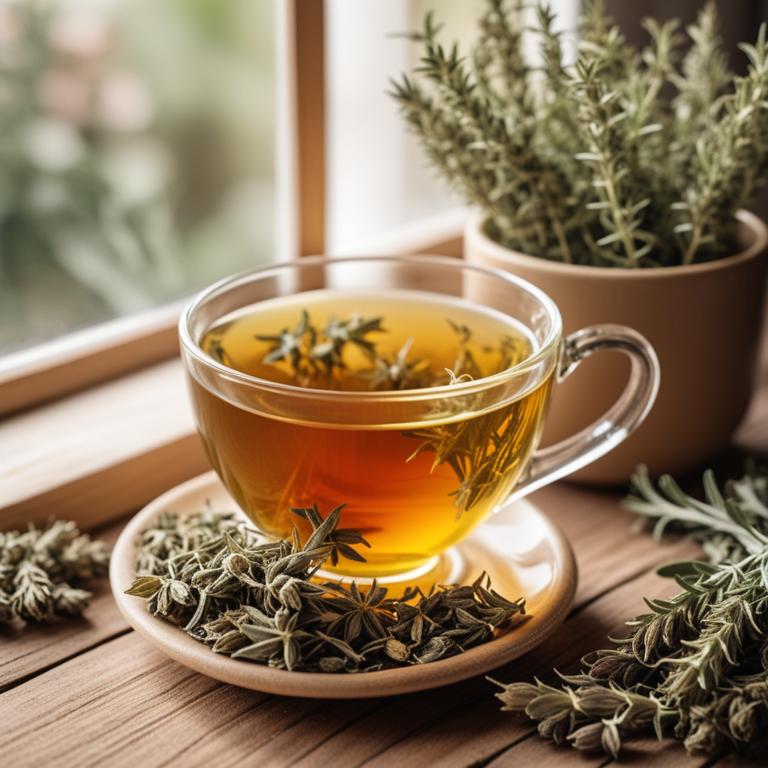
Herbal teas for Mucus in throat are natural remedies used to soothe and calm the throat, providing relief from excess mucus and congestion.
These teas can treat the ailment by loosening and clearing out mucus, reducing inflammation and congestion, and promoting a healthy cough to help expel mucus from the body.
Examples of herbal teas that can be used to treat mucus in the throat include ginger tea, which has anti-inflammatory properties to reduce swelling and ease congestion; eucalyptus tea, which has decongestant properties to help clear out mucus; peppermint tea, which has a cooling effect to soothe the throat and ease coughs; thyme tea, which has antimicrobial properties to combat underlying infections; and slippery elm tea, which has demulcent properties to soothe and protect the mucous membranes.
By incorporating these herbal teas into one's diet, individuals can find natural relief from mucus in the throat and promote overall respiratory health.
Related Study
According to "Medicina (Kaunas, Lithuania)", teas for mucus in throat can be soothing and relieve dry, tiresome cough due to the mucilage present in medicinal herbs such as marshmallow roots and Iceland moss.
Below there's a list of the 9 best herbal teas for mucus in throat.
Table of Contents
Also, you may be interested in...
Today Free Bonus!
The Ultimate Herb Drying Checklist
(For Long-Lasting Powerful Medicinal Effect)
How to easily dry herbs that don't mold and that keep their strong medicinal power for more than 1 year.
1. Eucalyptus globulus teas
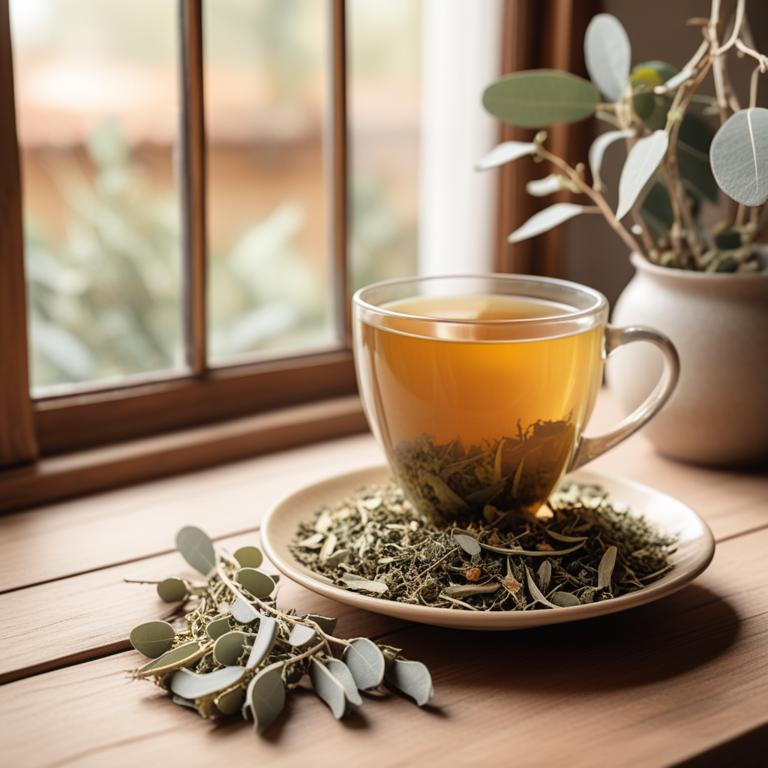
Eucalyptus globulus teas have been widely used to treat the mucus in throat ailment due to its decongestant and expectorant properties.
The herbal preparation helps to treat this ailment by relieving congestion, reducing inflammation, and thinning mucus, making it easier to expel.
The bioactive constituents of eucalyptus globulus teas, including eucalyptol, limonene, and alpha-pinene, are responsible for its therapeutic effects, as they exhibit anti-inflammatory, antimicrobial, and bronchodilatory activities.
The benefits of using eucalyptus globulus teas to treat the mucus in throat ailment include quick relief from symptoms, reduced risk of complications, and a natural alternative to conventional medications.
Related Study
According to "Evidence-based complementary and alternative medicine : eCAM", Eucalyptus globulus teas for mucus in throat are among the traditional remedies used in Ethiopia, particularly effective in treating cough, which is the most commonly cited respiratory disorder.
Recipe:
- Gather 1 cup of fresh Eucalyptus globulus leaves or 1 teaspoon of dried leaves.
- Boil 1 cup of water in a pot and remove from heat.
- Add the Eucalyptus leaves to the hot water and let it steep for 5-7 minutes.
- Strain the tea using a fine-mesh sieve or cheesecloth into a cup.
- Drink the tea while it's warm, up to 3 times a day as needed.
Eucalyptus globulus teas can be beneficial in treating the mucus in throat ailment, but possible side effects may include digestive issues, allergic reactions, and interactions with certain medications.
Precautions should be taken when using Eucalyptus globulus teas to treat this ailment, such as consuming it in moderation, avoiding it during pregnancy and breastfeeding, and monitoring for any adverse reactions, especially when combined with other herbal remedies.
Eucalyptus Globulus Tea on Amazon
Jovvily Eucalyptus Leaves - 1lb - Dried - Cut & Sifted - Herbal Tea
Disclaimer: We earn a commission if you click this link and make a purchase at no additional cost to you.
2. Echinacea purpurea teas

Echinacea purpurea teas have been traditionally used to treat the mucus in throat ailment, commonly known as a sore throat, due to its anti-inflammatory and immunomodulatory properties.
This herbal preparation helps to treat the ailment by reducing inflammation and swelling in the throat, thereby relieving pain and discomfort.
The bioactive constituents of Echinacea purpurea teas, including alkylamides, glycosides, and phenolic acids, possess antimicrobial and antioxidant properties that help to combat infections and protect the throat from further damage.
Regular consumption of Echinacea purpurea teas may help to alleviate symptoms of a sore throat, promote healing, and reduce the risk of complications associated with this ailment.
Related Study
According to "The Cochrane database of systematic reviews", Echinacea purpurea teas for mucus in throat may be beneficial, as some preparations containing Echinacea extracts were found to be better than placebo in treating common colds.
Recipe:
- Gather 2 tablespoons of dried Echinacea purpurea flowers and 1 teaspoon of dried mint leaves.
- Measure 1 cup of boiling water and pour it over the Echinacea flowers and mint leaves in a cup.
- Let the mixture steep for 5-7 minutes to allow the herbs to release their flavor and benefits.
- Strain the tea into another cup using a fine-mesh sieve or cheesecloth to remove the herbs.
- Drink the tea while it's still warm, ideally 2-3 times a day to help soothe a sore throat and loosen mucus.
Echinacea purpurea teas can help alleviate the symptoms of a mucus in throat ailment, but some possible side effects include allergic reactions, such as skin rashes or hives, and interactions with other medications, like blood thinners.
To use Echinacea purpurea teas safely, it's essential to start with small doses and gradually increase as needed, and be cautious when consuming them for extended periods, as prolonged use may cause stomach upset or changes in blood sugar levels.
Echinacea Purpurea Tea on Amazon
BLUE TEA - Chamomile Tea - Butterfly Pea Flower -18 Count - Pyramid Tea Bag | DETOX TEA | Caffeine Free - Flower Based - Vegan - Non-Bitter - Natural Ingredients | Tin Packaging
Disclaimer: We earn a commission if you click this link and make a purchase at no additional cost to you.
3. Sambucus nigra teas
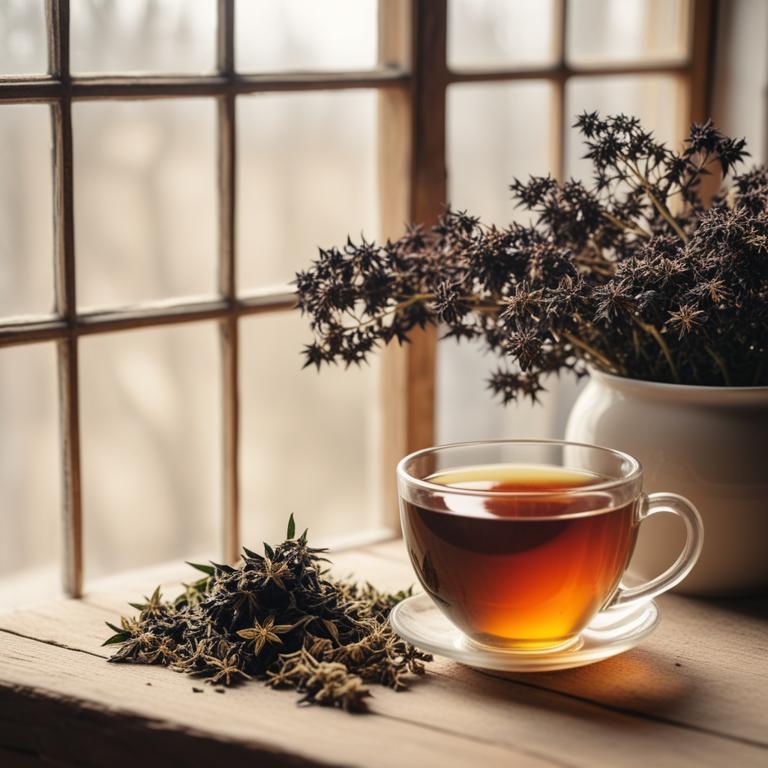
Sambucus nigra teas have been traditionally used to treat the mucus in throat ailment, also known as pharyngitis, due to their anti-inflammatory, antimicrobial, and expectorant properties.
The bioactive constituents of Sambucus nigra, including flavonoids, phenolic acids, and essential oils, help to reduce inflammation and kill bacteria that cause infection, thereby relieving symptoms such as soreness and congestion.
By reducing inflammation and promoting the expulsion of mucus, Sambucus nigra teas help to alleviate symptoms and speed up the recovery process, making it a popular natural remedy for this common ailment.
The benefits of using Sambucus nigra teas to treat the mucus in throat ailment include a reduction in the need for antibiotics, fewer side effects, and a more natural and holistic approach to healing.
Related Study
According to "The Journal of asthma : official journal of the Association for the Care of Asthma", Sambucus nigra teas have been found to have a positive effect on the clearance of mucus.
Recipe:
- Gather 1 cup of fresh or dried Sambucus nigra flowers, leaves, and berries. You can use 1:1 ratio of flowers to leaves and berries.
- Place the Sambucus nigra mixture in a heat-resistant cup or teapot. Add 1 cup of boiling water.
- Steep the mixture for 5-7 minutes. You can let it steep for longer if you prefer a stronger tea.
- Strain the tea into another cup using a tea strainer or cheesecloth to remove the solids. Discard the solids.
- Drink 1/2 cup to 1 cup of the tea, 2-3 times a day, to help relieve mucus in your throat.
Sambucus nigra teas can be used to treat the mucus in throat ailment, but possible side effects may include allergic reactions, stomach upset, and interactions with other medications such as blood thinners.
Precautions to take when using Sambucus nigra teas include being cautious if you have any allergies, avoiding taking it in large quantities, and not consuming it for extended periods of time.
Sambucus Nigra Tea on Amazon
Elderberry Turmeric Ginger Tea - Made in USA
Disclaimer: We earn a commission if you click this link and make a purchase at no additional cost to you.
4. Zingiber officinale teas

Zingiber officinale teas, derived from the root of the ginger plant, have been traditionally used to treat mucus in throat ailments due to their anti-inflammatory, expectorant, and antimicrobial properties.
The bioactive constituents, including gingerols and shogaols, help to thin mucus, reduce inflammation, and combat bacterial infections, thereby relieving congestion and discomfort.
By reducing inflammation and loosening mucus, Zingiber officinale teas help to alleviate symptoms associated with a mucus-filled throat, such as coughing, soreness, and difficulty swallowing.
The benefits of using Zingiber officinale teas to treat mucus in throat ailments include quick relief from symptoms, reduced risk of complications, and a natural, non-invasive approach to managing this common health issue.
Related Study
According to "Journal of ethnopharmacology", Zingiber officinale teas for mucus in throat have been traditionally used to cure various diseases, including cold, cough, and respiratory disorders, which implies that it may help alleviate mucus in the throat.
Recipe:
- Gather 1 teaspoon of dried Zingiber officinale root, 1 cup of boiling water, and a cup.
- Put the dried root in the cup.
- Pour 1 cup of boiling water over the root.
- Steep for 5-7 minutes, then strain the liquid.
- Drink the tea warm or at room temperature, up to 3 times a day.
Zingiber officinale teas can be effective in treating mucus in throat ailments, but they may cause side effects such as stomach upset, nausea, and dizziness due to the active compound gingerol.
To minimize these side effects, it is recommended to start with small doses and gradually increase the amount, avoid taking Zingiber officinale teas on an empty stomach, and be cautious of interactions with other medications, particularly blood thinners, and foods that may exacerbate stomach issues.
Zingiber Officinale Tea on Amazon
FGO Organic Ginger Tea, 100 Count, Eco-Conscious Tea Bags, Caffeine Free, Packaging May Vary (Pack of 1)
Disclaimer: We earn a commission if you click this link and make a purchase at no additional cost to you.
5. Glycyrrhiza glabra teas

Glycyrrhiza glabra teas, also known as licorice root tea, have been used to treat mucus in throat ailments due to their anti-inflammatory and expectorant properties.
The bioactive constituents of Glycyrrhiza glabra, including glycyrrhizin and flavonoids, help to reduce inflammation and mucus production in the throat, thereby alleviating symptoms associated with this condition.
By promoting the expulsion of mucus and soothing the throat, Glycyrrhiza glabra teas provide relief from coughing, congestion, and soreness, ultimately helping to clear the airways and restore normal breathing.
The benefits of using Glycyrrhiza glabra teas to treat mucus in throat ailments include natural and non-addictive relief from symptoms, reduced risk of side effects, and a cost-effective alternative to conventional medications.
Related Study
According to "Journal of the Medical Association of Thailand = Chotmaihet thangphaet", Glycyrrhiza glabra teas have shown strong antimicrobial activity against the bacteria that cause acute pharyngitis, including S. pyogenes ATCC 19615, S. pneumoniae ATCC 49619, and S. mutans ATCC 25175, indicating potential benefits in reducing mucus in the throat.
Recipe:
- Gather 1 cup of boiling water, 1 teaspoon of dried Glycyrrhiza glabra root, and a strainer.
- Steep the dried root in the boiling water for 5-7 minutes.
- Strain the mixture into a cup and discard the root.
- Add 1 tablespoon of honey to the tea if desired for taste.
- Drink the tea slowly and repeat as needed to help soothe a sore throat and loosen mucus.
Glycyrrhiza glabra teas can be beneficial in treating the mucus in throat ailment, but they may also cause side effects such as high blood pressure, edema, and potassium deficiency due to its licorice root content.
To use this herbal preparation safely, it is recommended to consume it in moderation, avoid long-term use, and monitor blood pressure and potassium levels, as excessive consumption can lead to these adverse effects.
Glycyrrhiza Glabra Tea on Amazon
Pukka Herbal Teas Licorice and Cinnamon - 20 Bags, 20 Count
Disclaimer: We earn a commission if you click this link and make a purchase at no additional cost to you.
6. Mentha x piperita teas
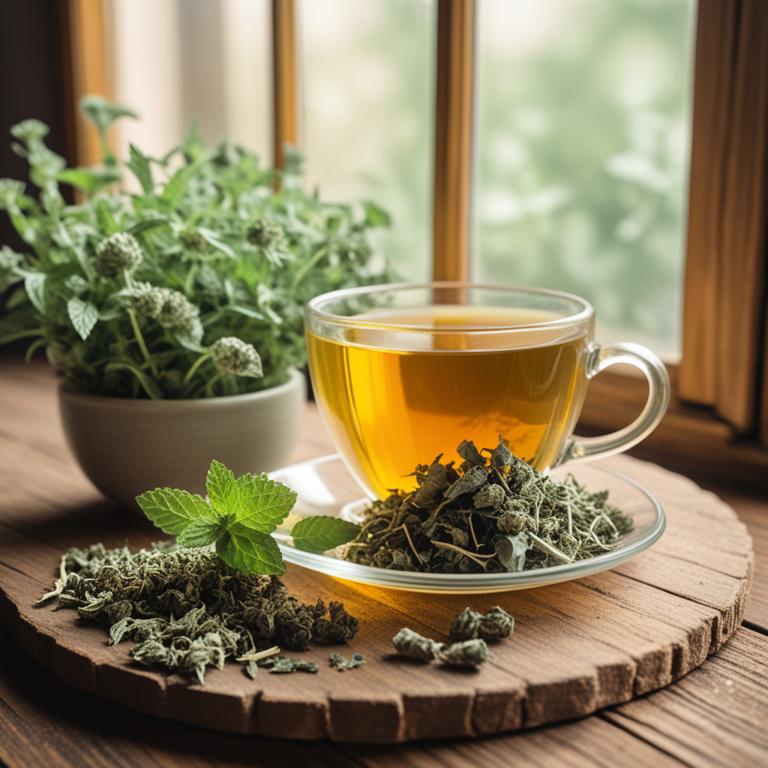
Mentha x piperita teas, also known as peppermint tea, have been traditionally used to treat the mucus in throat ailment due to their decongestant and anti-inflammatory properties.
The herbal preparation helps to treat this ailment by loosening and clearing excess mucus from the throat, thereby reducing congestion and discomfort.
The bioactive constituents of peppermint tea, including menthol and menthone, possess antimicrobial and anti-inflammatory properties that help to reduce inflammation and combat infection in the throat.
The benefits of using peppermint tea to treat this ailment include its natural, non-addictive, and non-irritating properties, making it a safe and effective remedy for soothing a sore throat.
Related Study
According to "The Journal of asthma : official journal of the Association for the Care of Asthma", Mentha x piperita teas for mucus in throat show positive effects, specifically resulting in the clearance of mucus.
Recipe:
- Gather 1 cup of fresh peppermint leaves (Mentha x piperita) or 1 teaspoon of dried peppermint.
- Boil 1 cup of water in a pot.
- Add the peppermint leaves or dried peppermint to the boiling water.
- Reduce heat and let it steep for 5-7 minutes.
- Strain the tea and drink it hot to help soothe a sore throat and loosen mucus.
Mentha x piperita teas can be used to alleviate mucus in the throat, but possible side effects may include stomach upset, nausea, and allergic reactions such as hives or itching.
To minimize risks, individuals should start with small doses, avoid consuming Mentha x piperita teas on an empty stomach, and refrain from using them for extended periods, as prolonged use may lead to tolerance and reduced effectiveness.
7. Thymus vulgaris teas
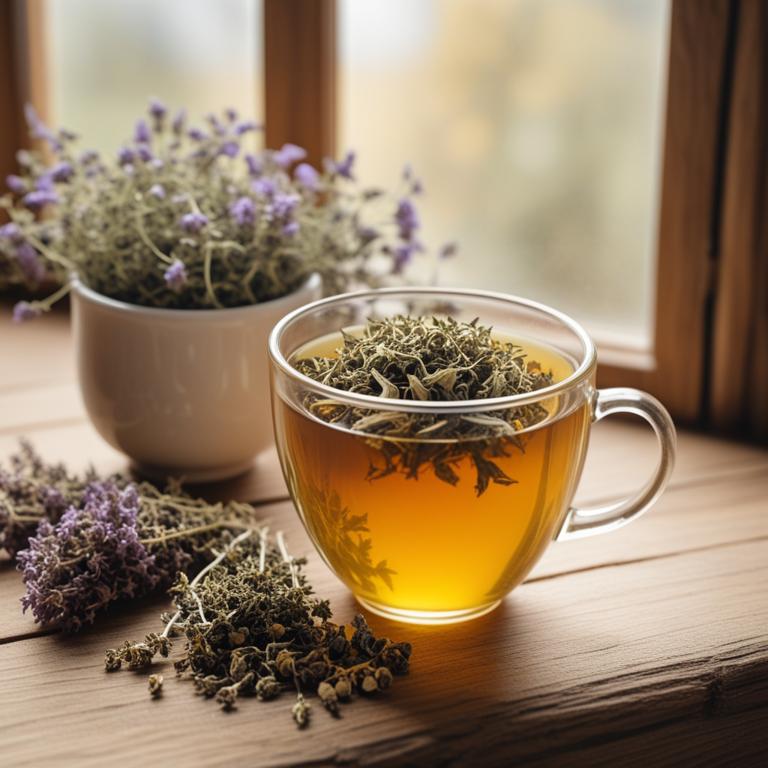
Thymus vulgaris teas, derived from the leaves of the thyme plant, have been used for centuries to treat various respiratory issues, including the mucus in throat ailment.
The antiseptic, anti-inflammatory, and expectorant properties of this herbal preparation help to treat this ailment by reducing inflammation and promoting the removal of excess mucus.
The bioactive constituents, including thymol and carvacrol, exhibit antimicrobial and mucolytic activities, breaking down mucus and inhibiting the growth of pathogens that contribute to the condition.
Regular consumption of Thymus vulgaris teas can provide relief from coughs, sore throats, and congestion, making it a beneficial treatment option for individuals suffering from this common ailment.
Related Study
According to "Ceska a Slovenska farmacie : casopis Ceske farmaceuticke spolecnosti a Slovenske farmaceuticke spolecnosti", Thymus vulgaris teas may be used in the treatment of respiratory tract diseases, including upper respiratory tract catarrh, due to its non-specific immunomodulation and antibacterial effects.
Recipe:
- Gather 1 tablespoon of dried Thymus vulgaris leaves and 1 cup of boiling water.
- Steep the dried leaves in the boiling water for 5-7 minutes.
- Strain the mixture into a cup using a fine-mesh sieve or cheesecloth.
- Add honey to taste, if desired, to help soothe the throat.
- Drink the tea 2-3 times a day to help relieve mucus in the throat.
Thymus vulgaris teas can help alleviate mucus in the throat due to its expectorant properties, but it may cause side effects such as stomach upset, diarrhea, and allergic reactions in some individuals, particularly those with sensitive skin or a history of allergies.
To use Thymus vulgaris teas safely, it's essential to start with small doses, gradually increase the amount as needed, and avoid consuming it before bedtime to minimize potential disruptions in sleep.
Thymus Vulgaris Tea on Amazon
Buddha Teas Organic Thyme Leaf Tea - OU Kosher, USDA Organic, CCOF Organic, 18 Bleach-Free Tea Bags
Disclaimer: We earn a commission if you click this link and make a purchase at no additional cost to you.
8. Rosmarinus officinalis teas

Rosmarinus officinalis teas, made from the fragrant herb rosemary, have been traditionally used to treat the mucus in throat ailment due to their decongestant and anti-inflammatory properties.
The bioactive constituents such as camphor, borneol, and bornyl acetate in rosemary teas help to break down mucus and reduce inflammation in the throat, providing relief from congestion and discomfort.
The anti-inflammatory properties of rosemary teas also help to soothe the mucous membranes, reducing inflammation and promoting healing.
The benefits of using rosemary teas to treat the mucus in throat ailment include rapid relief from congestion, reduced risk of secondary infections, and a soothing effect on the throat, making it an effective and natural remedy for this common ailment.
Recipe:
- Gather 2 tablespoons of dried Rosmarinus officinalis leaves and 1 cup of boiling water.
- Steep the leaves in the boiling water for 5-7 minutes, then strain the liquid.
- Add 1 tablespoon of honey to the tea, if desired, to sweeten the flavor.
- Drink the tea warm, 2-3 times a day, to help soothe mucus in the throat.
- Store any leftover tea in the refrigerator for up to 24 hours and reheat it as needed.
Rosmarinus officinalis teas can be effective in treating the mucus in throat ailment, but possible side effects may include allergic reactions, such as hives or itching, and digestive issues, such as nausea or stomach upset.
Precautions to take when using Rosmarinus officinalis teas include starting with small doses to assess tolerance and avoiding consumption before bedtime to minimize potential disruptions to sleep patterns.
Rosmarinus Officinalis Tea on Amazon
Palm Beach Medicinal Herbs - Rosemary Tea - Pure Herbal Tea Series, 30ct
Disclaimer: We earn a commission if you click this link and make a purchase at no additional cost to you.
9. Lavandula angustifolia teas

Lavandula angustifolia teas, also known as English lavender tea, have been traditionally used to treat the mucus in throat ailment, also known as phlegm or congestion.
The properties of this herbal preparation, including its anti-inflammatory and antimicrobial properties, help to reduce inflammation and combat bacterial and viral infections in the throat, thereby alleviating the symptoms of this ailment.
The bioactive constituents of Lavandula angustifolia tea, such as linalool and linalyl acetate, contribute to its therapeutic effects by inhibiting the growth of pathogens and reducing the production of mucus.
The benefits of using Lavandula angustifolia tea to treat this ailment include its natural and non-addictive properties, making it a safe and effective alternative to conventional medications.
Recipe:
- Gather 1 cup of fresh Lavandula angustifolia flowers or 1 teaspoon of dried flowers.
- Heat 1 cup of water in a pot and bring it to a boil.
- Reduce heat and add the Lavandula angustifolia flowers to the water.
- Steep the flowers for 5-7 minutes, then strain the liquid into a cup.
- Drink the tea while it's warm to help soothe a sore throat and reduce mucus.
Lavandula angustifolia teas can be used to help alleviate the symptoms of a mucus-filled throat, but possible side effects may include drowsiness, digestive upset, and allergic reactions in some individuals.
To minimize potential side effects, it is recommended to start with a small dose, avoid consuming the tea in large quantities, and be cautious when combining it with other medications or substances that may interact with its active compounds.
Lavandula Angustifolia Tea on Amazon
Tiesta Tea - Lavender Chamomile Herbal Tea | Loose Leaf | Calming Blend with Chamomile and Lavender | Caffeine-Free Herbal | Great for Hot or Iced Brews | Resealable Bulk Pouch, 200 Cups | 8 Ounce
Disclaimer: We earn a commission if you click this link and make a purchase at no additional cost to you.